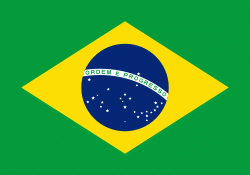Pelotas
 |
 |
In the 19th century, Pelotas was Brazil's leading center for the production of dried meat (charque), a staple food made by slaves and destined to feed the slaves of sugarcane, coffee and cocoa plantations across the country.
Currently Pelotas hosts two major universities, the Federal University of Pelotas, and the Catholic University of Pelotas. Together, they account for a population of 22 thousand higher education students.
The city has three football clubs: Esporte Clube Pelotas (founded 1908), Grêmio Esportivo Brasil (also known as Brasil de Pelotas; founded 1911) and Grêmio Atlético Farroupilha (founded 1926).
The history of the city begins in June 1758, through a donation that Gomes Freire de Andrade, Count of Bobadela, made to Colonel Thomáz Luiz Osório, giving him land that lay on the banks of the Lagoa dos Patos. In 1763, fleeing the Spanish invasion, many inhabitants of the village Rio Grande sought refuge in the land belonging to Osório. Later, there also came refugees from Colônia do Sacramento, which had been handed over by the Portuguese to the Spanish in 1777.
In 1780, the Portuguese rancher José Pinto Martins established himself in Pelotas. The prosperity of his establishment stimulated the creation of other ranches and growth in the region, creating a population that would define the early city.
The Civil Parish of São Francisco de Paula, founded on 7 June 1812, by Father Pedro Pereira de Mesquita, was elevated to the category of town on 7 April 1832. Three years later, in 1835, the town was declared a city, bearing the name Pelotas.
In southern Brazil, 'pelota' can refer to a leather raft, and the name of the city comes from the boats made of cockspur coral tree covered with animal skins, used to cross rivers in ranching times.
In the first years of the 20th century, progress was stimulated by the Banco Pelotense (Bank of Pelotas), founded in 1906 by local investors. Its liquidation, in 1931, was devastating to the local economy.
In 1990, the Urban Conurbation of Pelotas was created as a result of a state law. In 2001, it became the Urban Conurbation of Pelotas and Rio Grande, and in 2002 the Urban Conurbation of the South. The goal is to integrate the participating towns and is the embryo of a future metropolitan region including the towns os Arroio do Padre, Capão do Leão, Pelotas, Rio Grande and São José do Norte, which have a total population of around 600,000 inhabitants.
Map - Pelotas
Map
Country - Brazil
Currency / Language
| ISO | Currency | Symbol | Significant figures |
|---|---|---|---|
| BRL | Brazilian real | R$ | 2 |
| ISO | Language |
|---|---|
| EN | English language |
| FR | French language |
| PT | Portuguese language |
| ES | Spanish language |

















